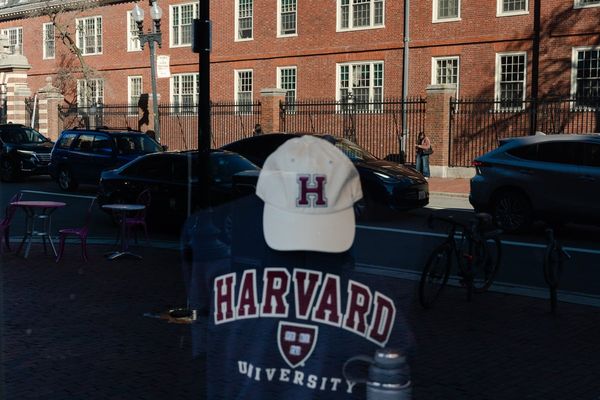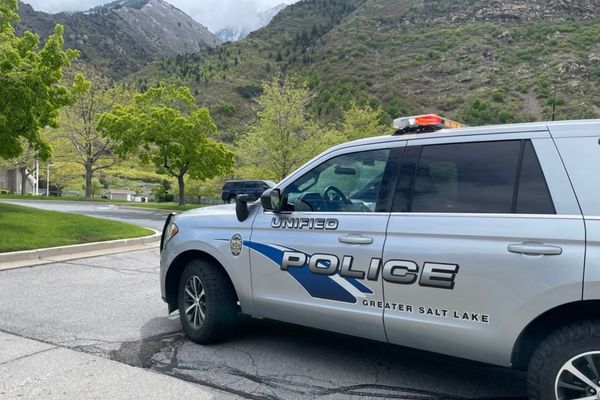
An alphabet of writhing tadpoles and globules, blots and worms crosses the paper, an underwater language of indecipherable signs. Is that a comma? Is this an octopus? Looking up, I notice that some of this stuff has broken free of the surface of the framed drawing and floated up to the ceiling, where it is trapped between the wall and the skylight, like a drifting tangle of seaweed. Some invisible current is pulling at the tendrils of colour, which tails off into the whiteness of the wall. It is like a conjurer’s misdirection, leading us from one thing to another, then back again.
Another surface is sticky with biomorphic blobs that have been coaxed into the shapes of the crests of waves and lakes of fire: if this were some band’s album sleeve, I’d be embarrassed to be seen walking around with it, though some of the best records have terrible covers. There is something hypnotic and even hallucinatory about many of Richard Wright’s images, with their wealth of abstract detail, their variousness and shifts in tempo and approach. His art asks you to pay close attention. Surprisingly, this is the largest exhibition Wright has had in the UK since winning the Turner prize in 2009. It is worth the wait.
Sometimes hectic, often enveloping and filled with variety and strangeness, tumbling references and secretive allusions, Wright’s weird landscapes and abstract patterns, with all their Rorschach-like unfoldings and mirrorings, are so compelling I lose myself, time and again, in his imaginary and constructed worlds, his plays with form and formlessness. My eye goes for a swim in them. Looking at Wright’s work is one thing, describing it another. My eye quivers and dances and won’t settle. Even my smartphone has trouble keeping up with the almost cinematic tonal flicker of black and white, and the simultaneous colour contrasts.
The florid and weirdly organic gives way to a sort of visual Lego that comprises chequerboard grids and runs of chevrons and angled tracks of parallel black and white stripes. They abut and shimmy apart. There’s a great deal of optical noise and interference, though Wright does his best to keep things under control. I keep getting sucked in by the places where the hand-painted geometry has gone wonky, and skidding off to other sections where the colour has switched and the tessellations have changed scale. Sometimes, the grids seem to warp and fold in on themselves. They pulse and flex with a kind of peripheral optical disturbance at the edges of my vision. I’m getting the whirling pits, and not for the first time.
Sometimes I think I’m looking at a landscape or a faded oriental carpet or a piece of painted silk. Suddenly, a bulky 1920s solicitor’s cabinet arrives, which, for no clear reason, has been embellished with a jazzy black and white design reminiscent of dazzle camouflage. It stands in the gallery like some big fat vorticist elephant, out of place and time. There are delicate drawings using gold leaf on paper which defeat any attempt to focus – I keep snatching at patterns and shapes, perhaps even images, then losing them again in the surface glare. Here’s an erupting gold-leaf splat, the edges of the apparently free-form event a totally premeditated and ornamental, frozen moment, a slow-motion explosion that keeps on happening.
I hadn’t been in Wright’s show long before I gave up trying to work out what systems and rules he was using to make his art, though in one room there’s a big old library table covered in books and drawings that provide a sort of clue. Wright has sometimes drawn and painted and collaged on to the pages of the books themselves: a pattern much like medieval floor tiling flexes on the open pages of Aldous Huxley’s The Doors of Perception, the text flitting from El Greco to Ingres to drapery and to Botticelli, in a flight of mescaline intoxication.
Images of gesticulating hands obscure the writing in Nietzsche’s Thus Spake Zarathustra. Wright has tinted-in the diagrams in an old manual about poster design, and defaced Maoist tracts and the poems of Vladimir Mayakovsky with lovely bits of constructivist watercolour doodling. You could spend a happy afternoon poring over all this. Look, there’s a rare artist’s book by Ed Ruscha, sitting on top of a couple of volumes of occultist nonsense. Here’s a sheet of marbled endpaper, and an analysis of the mathematics behind the geometries of Islamic architectural decoration. All these layered references have caught Wright’s attention and fed, in various ways, the cosmologies of his art, which is as labyrinthine as a story by Jorge Luis Borges. It is like being trapped in the artist’s head.
In a watercolour that could almost have been made centuries ago, perhaps by some amateur romantic on his Italian grand tour, a hill rises from a flat plain, with odd, furtive things going on in the thin washes of grey paint. Something else seems to be hiding in one of Wright’s symmetrical fields of abstract squiggles and hatchings. If I were told that this last work had been painted by some dope-fiend acquaintance of Aleister Crowley while engaged in a summoning of demons, I would not be at all surprised. Elsewhere, there are painstaking studies of architectural oddities: a set of shallow steps with alcoves scalloped beneath them, and a plain Renaissance facade of a crenelated tower, untethered from its place in a painted 15th-century urban backdrop. I love the way Wright leads you first one way, then another.
In the open space between the galleries at Camden Art Centre, Wright has installed large metal screens inset with leaded glass, hanging them beneath the skylights, to cast refracted sunlight (when there is any) on to the walls and floors. Another screen has been placed in front of a light well (usually hidden from view behind a false wall in the gallery’s reading room). Mostly, you enter Wright’s work through an act of imagination. These ornamental, architectural interventions extend Wright’s work into real space. Instead of looking at his art, you find yourself inside it.
The same is true of the in-situ drawings he has made on walls and ceilings, stairwells and vestibules, from the Elizabeth Line at Tottenham Court Road station in London to the Rijksmuseum in Amsterdam and the Queen’s House in Greenwich. For the past five weeks, Wright has been working on a wall drawing at Camden, the product of weeks of labour by the artist and his team of assistants. Climbing from the floor up into the high, barrel-vaulted roof where it makes its way across the ceiling, a complex fractal geometry of triangles morphs into rhomboids and chevrons, canted this way and that.
They change scale, they proliferate, they turn into six-pointed stars, they split apart, they sheer and do weird things too far away for my eye to properly register and comprehend. The fact that something is happening up there is enough, as Wright moves from optical space to mental space, a place for the imagination as well as the eye.
Richard Wright is at Camden Art Centre, London, until 22 June.







